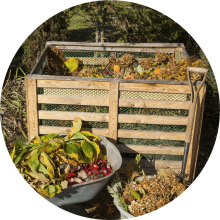Composting
What is composting?
Composting is the process of recycling organic materials into an amendment that can be used to enrich soil and plants.
Types of Compost Bins
Typical Compost Bin
Tumbler Compost Bin
Worm Compost Bin
Why Compost?
Food scraps and yard waste currently make up 20 to 30 percent of what we throw away. USDA is fighting food waste and you can too.
Composting is nature’s way of recycling! Here are a few reasons to get started today:
- Feed the soil without using chemical fertilizers.
- Keep food waste out of the landfills and prevent greenhouse gas emissions.
- Conserve water by building healthy soils.
Get Started
There are different ways to get started composting today. You can start a backyard composting bin or use worms to do the work.
Backyard composting in three easy steps:
- Choose a location. A good site is dry in either the sun or partial shade.
- Set-up your compost bin. Purchase a compost bin or create an inexpensive bin with wire mesh and 3-4 poles for support.
- Get composting. Include 2-3 parts “brown material” (fall leaves, twigs, shredded newspaper, straw, wood chips, and shredded wood) and 1 part “green material” (vegetable and fruit scraps, coffee grounds, crushed eggshells, garden and grass clippings, tea bags without staples) by volume then add water to keep moist. Don’t forget to turn your pile! A monthly rotation is a good rule of thumb.
Worm Composting Setup:
- Select Container. Purchase a worm bin or make your own from a plastic or wood storage container. Worm bins require holes drilled for aeration and drainage. There are several online sources with instructions to create a worm bin.
- Locate bin. The ideal temperature for worm composting is 59-77 degrees F. The bin can be kept indoors or outdoors in the shade. During colder months, insulate the worm bin with blankets, straw, or other material to keep it warm.
- Worm Bin Setup:
- Worms need bedding such as a mixture of non-glossy paper, cardboard, or leaves. Soak the material for 10 minutes, wring out the water so it is moist but not saturated, and place it in the bin with a handful of soil.
- Now you are ready to add your worms. There are over 9,000 species of earthworms, but only 7 are suitable for vermicomposting. The most widely used species is the “red wiggler” which you can buy from a worm grower. Do not use worms from a bait shop or your garden since they will not be able to thrive in your worm bin.
- Feed your worms veggie and fruit scraps, coffee grounds, eggshells, and moistened bread. Avoid meat, fish, dairy products, citrus fruits, twigs and branches.
Learn more
- Composting Fact Sheet (PDF, 620 KB) | Composting Fact Sheet Spanish (PDF, 882 KB) | Composting Fact Sheet (JPG, 489 KB)
- Composting at Home – Environmental Protection Agency
- Master Composter Guide – Cornell University
- How Worms Can Recycle Your Garbage - North Caroline State Cooperative Extension




